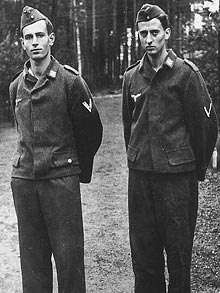Walter Morison
| Walter McDonald Morison | |
|---|---|
 Walter Morison (Right) with Lorne Welch after being recaptured wearing German Luftwaffe uniforms following the Delousing break in 1943 | |
| Born |
26 November 1919 Beckenham, Kent, England |
| Died | 26 March 2009 (aged 89) |
| Allegiance |
|
| Service/branch |
|
| Years of service | 1939–1945 |
| Rank | Flight Lieutenant |
| Unit | No. 103 Squadron RAF |
| Battles/wars | World War II |
Flight Lieutenant Walter McDonald Morison (26 November 1919 – 26 March 2009) was a Royal Air Force pilot who became a prisoner of war and was sent to Colditz for attempting to steal an enemy aircraft during the Second World War.
Royal Air Force service
Morison joined the Royal Air Force at the outbreak of war in September 1939, and was trained as a pilot. He was commissioned as a Pilot Officer on 30 November 1940.[1]
On the night of 5/6 June 1942 he was in collision with Wellington X3339 from 156 Squadron piloted by Sgt Guy Chamberlin RAFVR, flying a Wellington bomber and he became a prisoner of war. He was the sole survivor of the 5 man crew.[2] Walter Morison had been Guy Chamberlin's instructor at RAF Lossiemouth around the beginning of 1942.[3] All the crew of X3339 were killed and are buried in the same row at the Reischwald Forest War Cemetery near Kleve in Germany.[4]
He was sent to Stalag Luft III POW Camp at Sagan.
He was promoted to Flight Lieutenant on 30 November 1942 whilst being held as a POW [5]
On 12 June 1943, Morison with 25 others escaped from the camp during what was known as the delousing break. Accompanied by Flight Lieutenant Lorne Welch they walked to a nearby airfield and attempted to steal an aircraft, but had to abandon the attempt when the aircraft crew appeared to fly away the aircraft. Shortly afterwards they were recaptured and sent to Oflag IV-C at Colditz.[6]
He was liberated from Colditz by the American army in April 1945.
Postwar
Following the war, Morison qualified as a chartered accountant at the Institute of Chartered Accountants in England & Wales. He was articled at Morison, a firm established by his great uncle. Morison then worked at Coopers Bros, the firm that became Coopers & Lybrand, before returning to his family firm, Morison Stoneham. He led the firm as a senior partner through a period of great change from 1960 to 1981 before retiring. Whilst Morison Stoneham was acquired by Tenon (later known as RSM Tenon) one of his legacies that still exists today is Morison International[7] a global association of professional service firms (accountants, auditors, tax and business advisers).
Morison wrote an account of his life during the war Flak and Ferrets - One Way to Colditz. Morison died on 26 March 2009.[8]
References
- ↑ The London Gazette: (Supplement) no. 35028. p. 7300. 31 December 1940. Retrieved 25 August 2009.
- ↑ Chorley, W. R. (3 Jan 1998). Bomber Command Losses 1942. Midland Publishing. p. 318. ISBN 978-0-904597-89-9. page 119
- ↑ According to David Chamberlin (Guy's Son) following a meeting with Walter Morison and with reference to his service log-book.
- ↑ "Casualty Details: Chamberlin, Guy Hesketh". Commonwealth War Graves Commission. Retrieved 14 July 2011.
- ↑ The London Gazette: (Supplement) no. 35936. p. 1191. 12 March 1943. Retrieved 25 August 2009.
- ↑ Morison, Walter (1995). Flak and Ferrets - One Way to Colditz. Sentinel. ISBN 978-1-874767-10-7.
- ↑ Walter Morison November 1919 - March 2009
- ↑ "Obituary - Flight Lieutenant Walter Morison". www.telegraph.co.uk. 23 April 2009. Retrieved 25 August 2009.